Evaluating Competitive Strategy: PESTLE, Resource-Based View & SWOT
VerifiedAdded on 2023/06/12
|8
|1800
|137
Essay
AI Summary
This essay provides a detailed analysis of competitive strategy using three key frameworks: PESTLE analysis, the Resource-Based View (RBV) model, and SWOT analysis. It begins by explaining the importance and application of PESTLE analysis in understanding the external environment, particularly within the Australian tourism sector, focusing on political, economic, social, technological, legal, and environmental factors. The essay then discusses the Resource-Based View, emphasizing the role of a company's resources and capabilities in achieving a competitive advantage. Finally, it examines SWOT analysis as a tool for identifying internal strengths and weaknesses, as well as external opportunities and threats, within the context of the tourism industry. The essay concludes by highlighting the importance of these strategic tools in forming sustainable advantages for businesses.
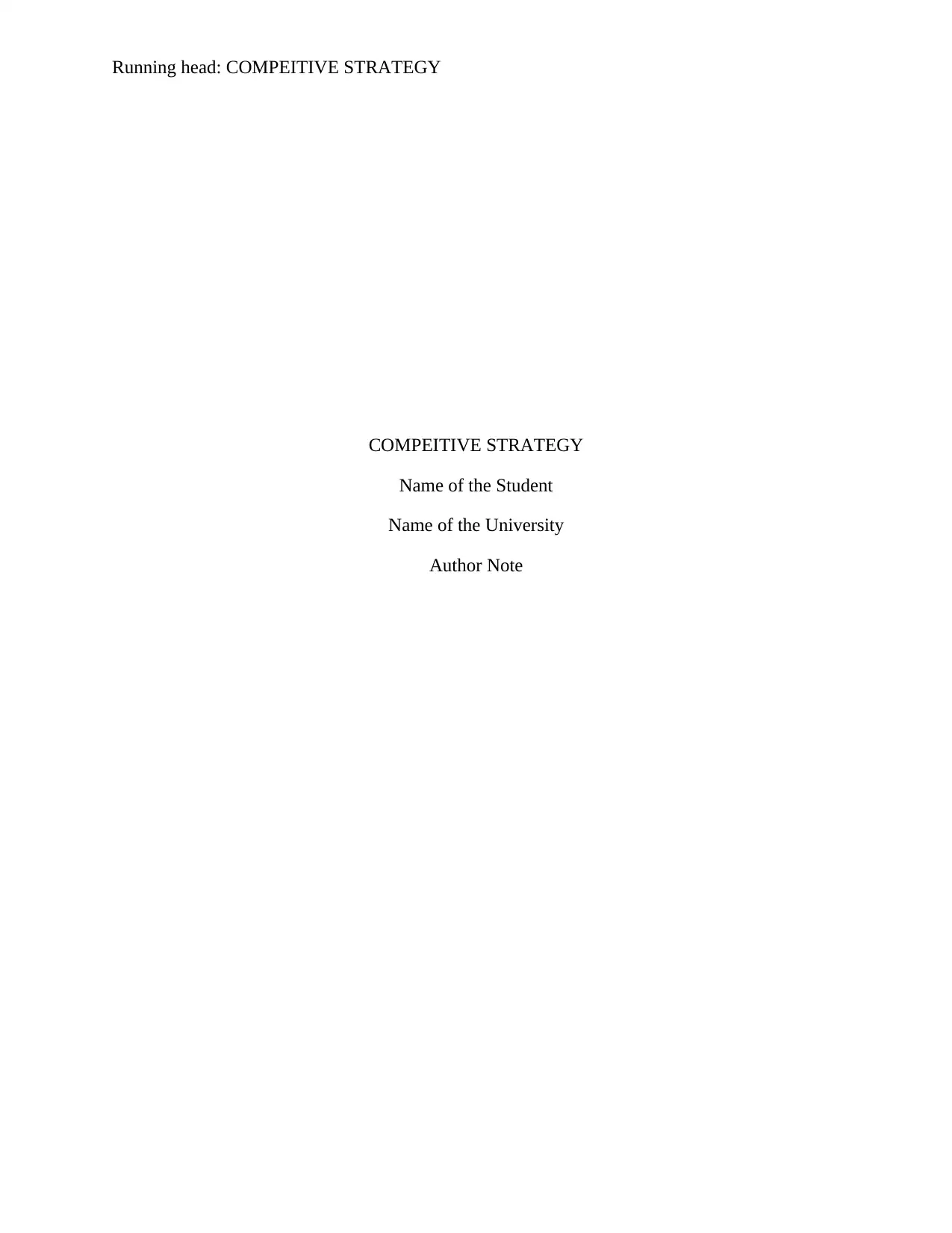
Running head: COMPEITIVE STRATEGY
COMPEITIVE STRATEGY
Name of the Student
Name of the University
Author Note
COMPEITIVE STRATEGY
Name of the Student
Name of the University
Author Note
Paraphrase This Document
Need a fresh take? Get an instant paraphrase of this document with our AI Paraphraser
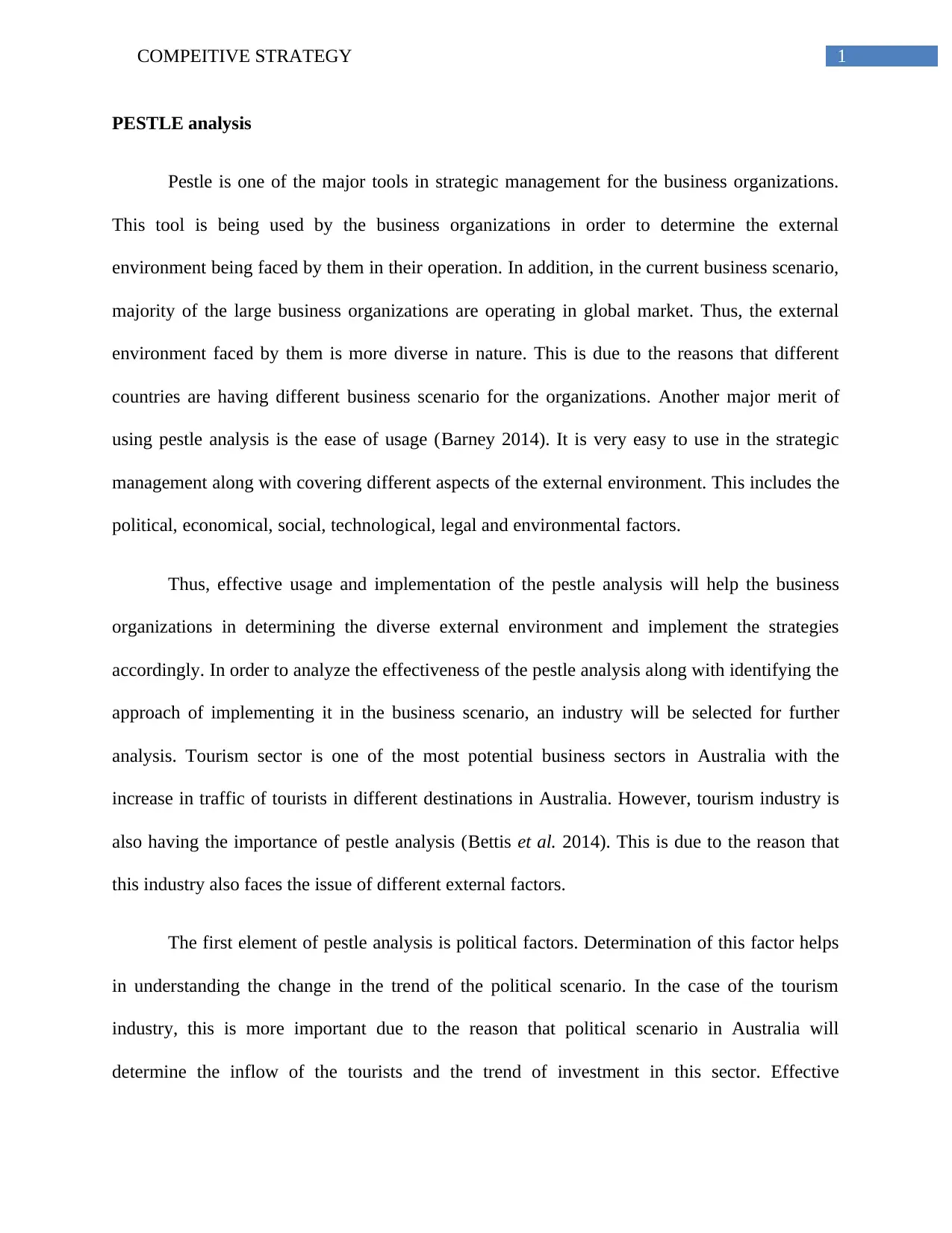
1COMPEITIVE STRATEGY
PESTLE analysis
Pestle is one of the major tools in strategic management for the business organizations.
This tool is being used by the business organizations in order to determine the external
environment being faced by them in their operation. In addition, in the current business scenario,
majority of the large business organizations are operating in global market. Thus, the external
environment faced by them is more diverse in nature. This is due to the reasons that different
countries are having different business scenario for the organizations. Another major merit of
using pestle analysis is the ease of usage (Barney 2014). It is very easy to use in the strategic
management along with covering different aspects of the external environment. This includes the
political, economical, social, technological, legal and environmental factors.
Thus, effective usage and implementation of the pestle analysis will help the business
organizations in determining the diverse external environment and implement the strategies
accordingly. In order to analyze the effectiveness of the pestle analysis along with identifying the
approach of implementing it in the business scenario, an industry will be selected for further
analysis. Tourism sector is one of the most potential business sectors in Australia with the
increase in traffic of tourists in different destinations in Australia. However, tourism industry is
also having the importance of pestle analysis (Bettis et al. 2014). This is due to the reason that
this industry also faces the issue of different external factors.
The first element of pestle analysis is political factors. Determination of this factor helps
in understanding the change in the trend of the political scenario. In the case of the tourism
industry, this is more important due to the reason that political scenario in Australia will
determine the inflow of the tourists and the trend of investment in this sector. Effective
PESTLE analysis
Pestle is one of the major tools in strategic management for the business organizations.
This tool is being used by the business organizations in order to determine the external
environment being faced by them in their operation. In addition, in the current business scenario,
majority of the large business organizations are operating in global market. Thus, the external
environment faced by them is more diverse in nature. This is due to the reasons that different
countries are having different business scenario for the organizations. Another major merit of
using pestle analysis is the ease of usage (Barney 2014). It is very easy to use in the strategic
management along with covering different aspects of the external environment. This includes the
political, economical, social, technological, legal and environmental factors.
Thus, effective usage and implementation of the pestle analysis will help the business
organizations in determining the diverse external environment and implement the strategies
accordingly. In order to analyze the effectiveness of the pestle analysis along with identifying the
approach of implementing it in the business scenario, an industry will be selected for further
analysis. Tourism sector is one of the most potential business sectors in Australia with the
increase in traffic of tourists in different destinations in Australia. However, tourism industry is
also having the importance of pestle analysis (Bettis et al. 2014). This is due to the reason that
this industry also faces the issue of different external factors.
The first element of pestle analysis is political factors. Determination of this factor helps
in understanding the change in the trend of the political scenario. In the case of the tourism
industry, this is more important due to the reason that political scenario in Australia will
determine the inflow of the tourists and the trend of investment in this sector. Effective
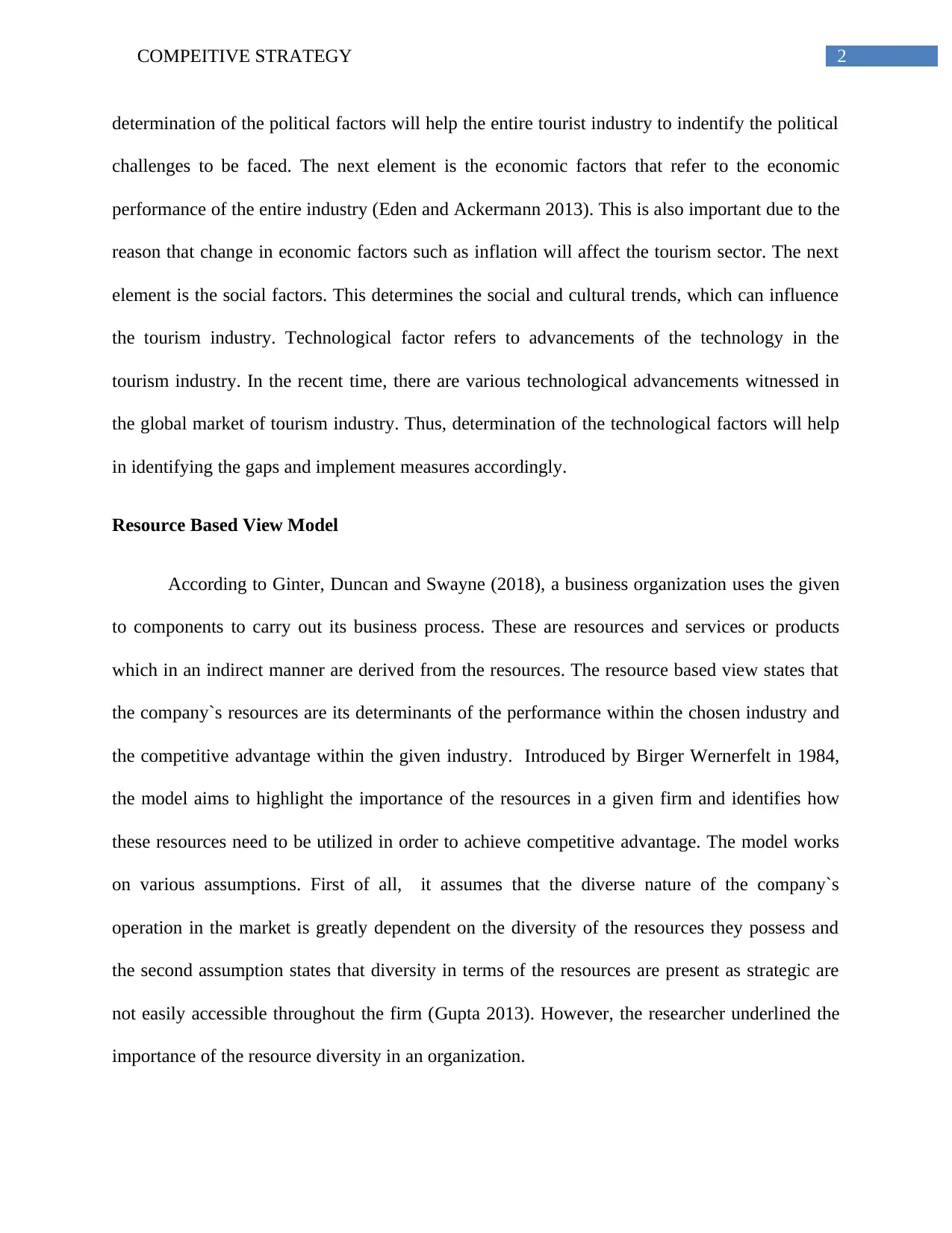
2COMPEITIVE STRATEGY
determination of the political factors will help the entire tourist industry to indentify the political
challenges to be faced. The next element is the economic factors that refer to the economic
performance of the entire industry (Eden and Ackermann 2013). This is also important due to the
reason that change in economic factors such as inflation will affect the tourism sector. The next
element is the social factors. This determines the social and cultural trends, which can influence
the tourism industry. Technological factor refers to advancements of the technology in the
tourism industry. In the recent time, there are various technological advancements witnessed in
the global market of tourism industry. Thus, determination of the technological factors will help
in identifying the gaps and implement measures accordingly.
Resource Based View Model
According to Ginter, Duncan and Swayne (2018), a business organization uses the given
to components to carry out its business process. These are resources and services or products
which in an indirect manner are derived from the resources. The resource based view states that
the company`s resources are its determinants of the performance within the chosen industry and
the competitive advantage within the given industry. Introduced by Birger Wernerfelt in 1984,
the model aims to highlight the importance of the resources in a given firm and identifies how
these resources need to be utilized in order to achieve competitive advantage. The model works
on various assumptions. First of all, it assumes that the diverse nature of the company`s
operation in the market is greatly dependent on the diversity of the resources they possess and
the second assumption states that diversity in terms of the resources are present as strategic are
not easily accessible throughout the firm (Gupta 2013). However, the researcher underlined the
importance of the resource diversity in an organization.
determination of the political factors will help the entire tourist industry to indentify the political
challenges to be faced. The next element is the economic factors that refer to the economic
performance of the entire industry (Eden and Ackermann 2013). This is also important due to the
reason that change in economic factors such as inflation will affect the tourism sector. The next
element is the social factors. This determines the social and cultural trends, which can influence
the tourism industry. Technological factor refers to advancements of the technology in the
tourism industry. In the recent time, there are various technological advancements witnessed in
the global market of tourism industry. Thus, determination of the technological factors will help
in identifying the gaps and implement measures accordingly.
Resource Based View Model
According to Ginter, Duncan and Swayne (2018), a business organization uses the given
to components to carry out its business process. These are resources and services or products
which in an indirect manner are derived from the resources. The resource based view states that
the company`s resources are its determinants of the performance within the chosen industry and
the competitive advantage within the given industry. Introduced by Birger Wernerfelt in 1984,
the model aims to highlight the importance of the resources in a given firm and identifies how
these resources need to be utilized in order to achieve competitive advantage. The model works
on various assumptions. First of all, it assumes that the diverse nature of the company`s
operation in the market is greatly dependent on the diversity of the resources they possess and
the second assumption states that diversity in terms of the resources are present as strategic are
not easily accessible throughout the firm (Gupta 2013). However, the researcher underlined the
importance of the resource diversity in an organization.
⊘ This is a preview!⊘
Do you want full access?
Subscribe today to unlock all pages.

Trusted by 1+ million students worldwide
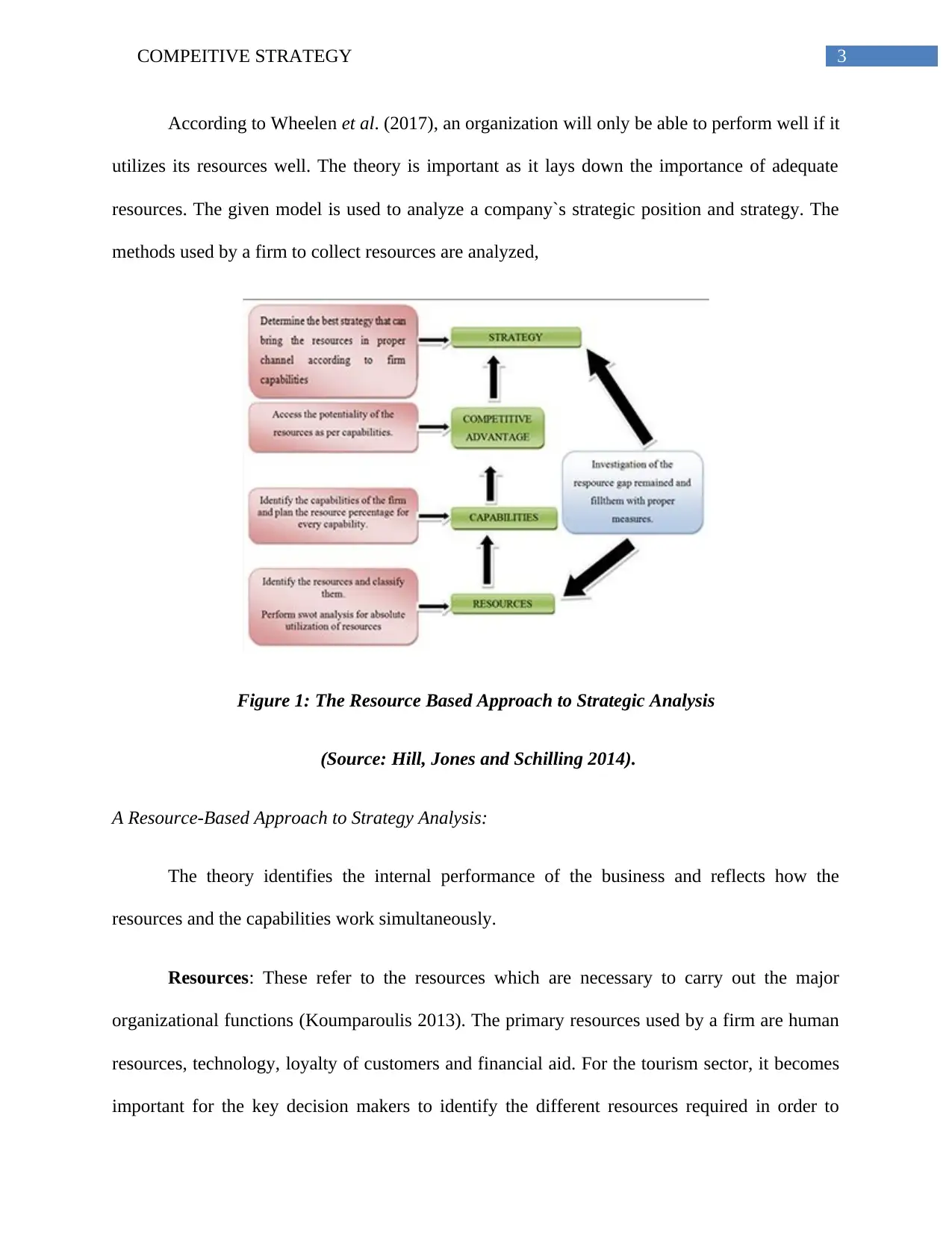
3COMPEITIVE STRATEGY
According to Wheelen et al. (2017), an organization will only be able to perform well if it
utilizes its resources well. The theory is important as it lays down the importance of adequate
resources. The given model is used to analyze a company`s strategic position and strategy. The
methods used by a firm to collect resources are analyzed,
Figure 1: The Resource Based Approach to Strategic Analysis
(Source: Hill, Jones and Schilling 2014).
A Resource-Based Approach to Strategy Analysis:
The theory identifies the internal performance of the business and reflects how the
resources and the capabilities work simultaneously.
Resources: These refer to the resources which are necessary to carry out the major
organizational functions (Koumparoulis 2013). The primary resources used by a firm are human
resources, technology, loyalty of customers and financial aid. For the tourism sector, it becomes
important for the key decision makers to identify the different resources required in order to
According to Wheelen et al. (2017), an organization will only be able to perform well if it
utilizes its resources well. The theory is important as it lays down the importance of adequate
resources. The given model is used to analyze a company`s strategic position and strategy. The
methods used by a firm to collect resources are analyzed,
Figure 1: The Resource Based Approach to Strategic Analysis
(Source: Hill, Jones and Schilling 2014).
A Resource-Based Approach to Strategy Analysis:
The theory identifies the internal performance of the business and reflects how the
resources and the capabilities work simultaneously.
Resources: These refer to the resources which are necessary to carry out the major
organizational functions (Koumparoulis 2013). The primary resources used by a firm are human
resources, technology, loyalty of customers and financial aid. For the tourism sector, it becomes
important for the key decision makers to identify the different resources required in order to
Paraphrase This Document
Need a fresh take? Get an instant paraphrase of this document with our AI Paraphraser
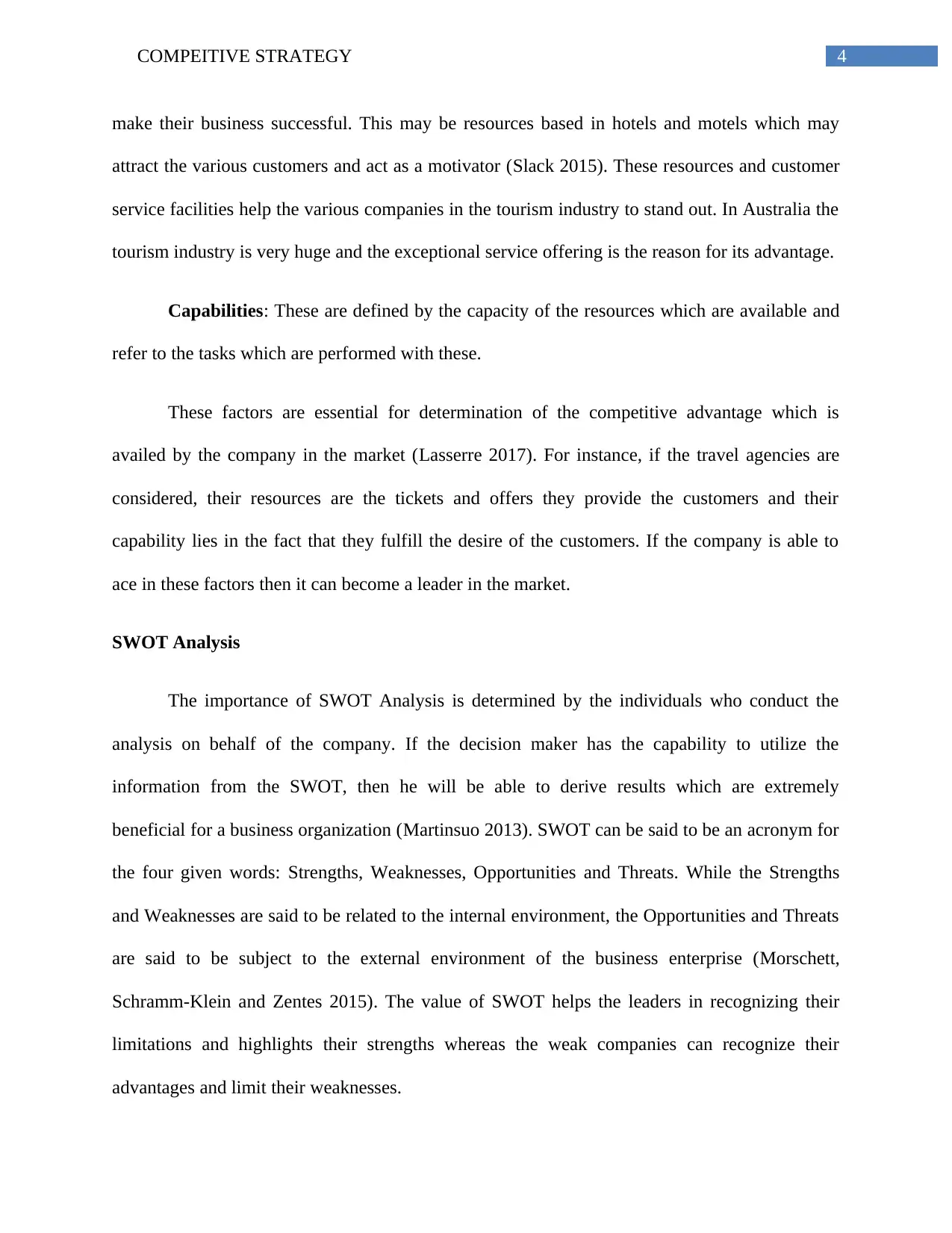
4COMPEITIVE STRATEGY
make their business successful. This may be resources based in hotels and motels which may
attract the various customers and act as a motivator (Slack 2015). These resources and customer
service facilities help the various companies in the tourism industry to stand out. In Australia the
tourism industry is very huge and the exceptional service offering is the reason for its advantage.
Capabilities: These are defined by the capacity of the resources which are available and
refer to the tasks which are performed with these.
These factors are essential for determination of the competitive advantage which is
availed by the company in the market (Lasserre 2017). For instance, if the travel agencies are
considered, their resources are the tickets and offers they provide the customers and their
capability lies in the fact that they fulfill the desire of the customers. If the company is able to
ace in these factors then it can become a leader in the market.
SWOT Analysis
The importance of SWOT Analysis is determined by the individuals who conduct the
analysis on behalf of the company. If the decision maker has the capability to utilize the
information from the SWOT, then he will be able to derive results which are extremely
beneficial for a business organization (Martinsuo 2013). SWOT can be said to be an acronym for
the four given words: Strengths, Weaknesses, Opportunities and Threats. While the Strengths
and Weaknesses are said to be related to the internal environment, the Opportunities and Threats
are said to be subject to the external environment of the business enterprise (Morschett,
Schramm-Klein and Zentes 2015). The value of SWOT helps the leaders in recognizing their
limitations and highlights their strengths whereas the weak companies can recognize their
advantages and limit their weaknesses.
make their business successful. This may be resources based in hotels and motels which may
attract the various customers and act as a motivator (Slack 2015). These resources and customer
service facilities help the various companies in the tourism industry to stand out. In Australia the
tourism industry is very huge and the exceptional service offering is the reason for its advantage.
Capabilities: These are defined by the capacity of the resources which are available and
refer to the tasks which are performed with these.
These factors are essential for determination of the competitive advantage which is
availed by the company in the market (Lasserre 2017). For instance, if the travel agencies are
considered, their resources are the tickets and offers they provide the customers and their
capability lies in the fact that they fulfill the desire of the customers. If the company is able to
ace in these factors then it can become a leader in the market.
SWOT Analysis
The importance of SWOT Analysis is determined by the individuals who conduct the
analysis on behalf of the company. If the decision maker has the capability to utilize the
information from the SWOT, then he will be able to derive results which are extremely
beneficial for a business organization (Martinsuo 2013). SWOT can be said to be an acronym for
the four given words: Strengths, Weaknesses, Opportunities and Threats. While the Strengths
and Weaknesses are said to be related to the internal environment, the Opportunities and Threats
are said to be subject to the external environment of the business enterprise (Morschett,
Schramm-Klein and Zentes 2015). The value of SWOT helps the leaders in recognizing their
limitations and highlights their strengths whereas the weak companies can recognize their
advantages and limit their weaknesses.
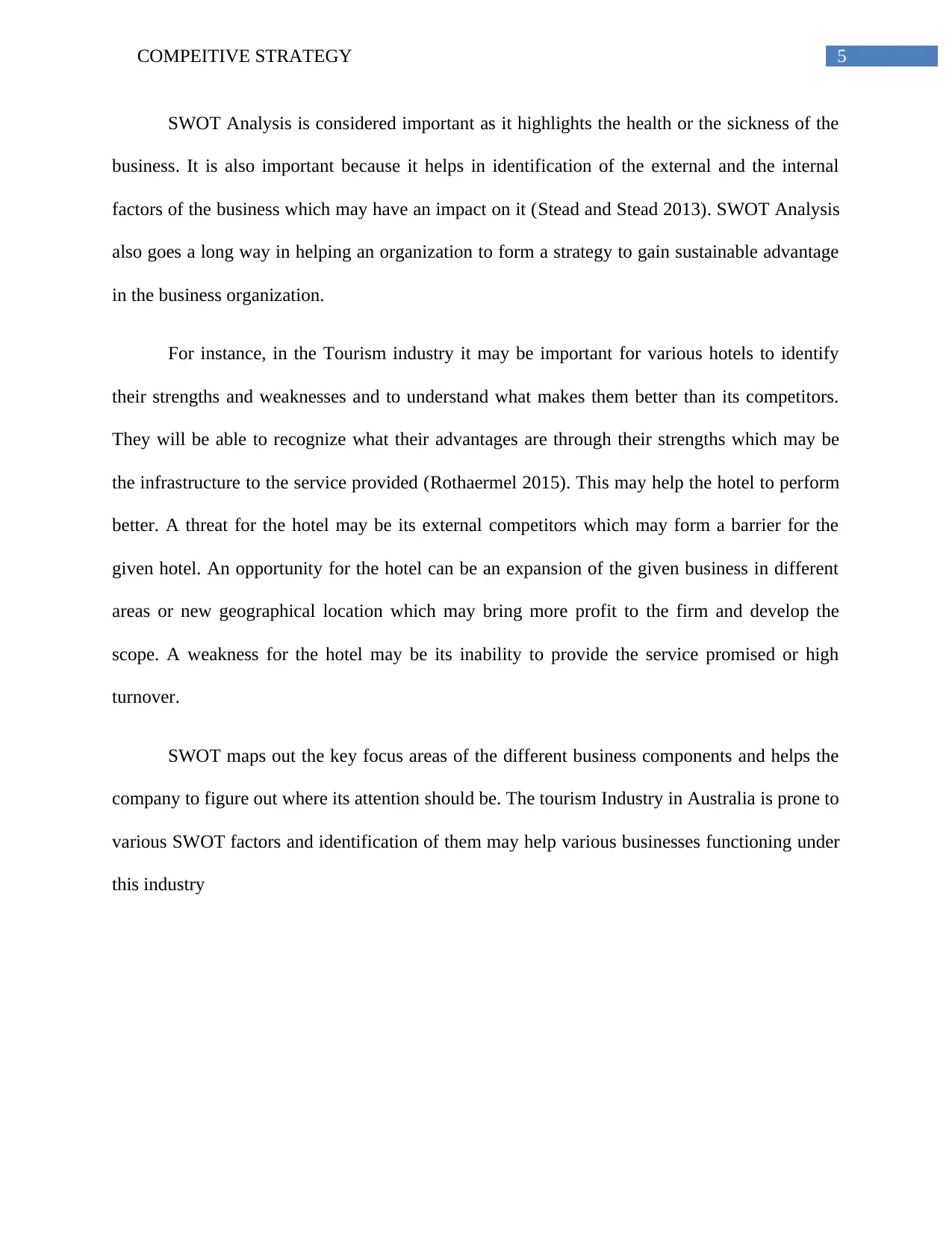
5COMPEITIVE STRATEGY
SWOT Analysis is considered important as it highlights the health or the sickness of the
business. It is also important because it helps in identification of the external and the internal
factors of the business which may have an impact on it (Stead and Stead 2013). SWOT Analysis
also goes a long way in helping an organization to form a strategy to gain sustainable advantage
in the business organization.
For instance, in the Tourism industry it may be important for various hotels to identify
their strengths and weaknesses and to understand what makes them better than its competitors.
They will be able to recognize what their advantages are through their strengths which may be
the infrastructure to the service provided (Rothaermel 2015). This may help the hotel to perform
better. A threat for the hotel may be its external competitors which may form a barrier for the
given hotel. An opportunity for the hotel can be an expansion of the given business in different
areas or new geographical location which may bring more profit to the firm and develop the
scope. A weakness for the hotel may be its inability to provide the service promised or high
turnover.
SWOT maps out the key focus areas of the different business components and helps the
company to figure out where its attention should be. The tourism Industry in Australia is prone to
various SWOT factors and identification of them may help various businesses functioning under
this industry
SWOT Analysis is considered important as it highlights the health or the sickness of the
business. It is also important because it helps in identification of the external and the internal
factors of the business which may have an impact on it (Stead and Stead 2013). SWOT Analysis
also goes a long way in helping an organization to form a strategy to gain sustainable advantage
in the business organization.
For instance, in the Tourism industry it may be important for various hotels to identify
their strengths and weaknesses and to understand what makes them better than its competitors.
They will be able to recognize what their advantages are through their strengths which may be
the infrastructure to the service provided (Rothaermel 2015). This may help the hotel to perform
better. A threat for the hotel may be its external competitors which may form a barrier for the
given hotel. An opportunity for the hotel can be an expansion of the given business in different
areas or new geographical location which may bring more profit to the firm and develop the
scope. A weakness for the hotel may be its inability to provide the service promised or high
turnover.
SWOT maps out the key focus areas of the different business components and helps the
company to figure out where its attention should be. The tourism Industry in Australia is prone to
various SWOT factors and identification of them may help various businesses functioning under
this industry
⊘ This is a preview!⊘
Do you want full access?
Subscribe today to unlock all pages.

Trusted by 1+ million students worldwide
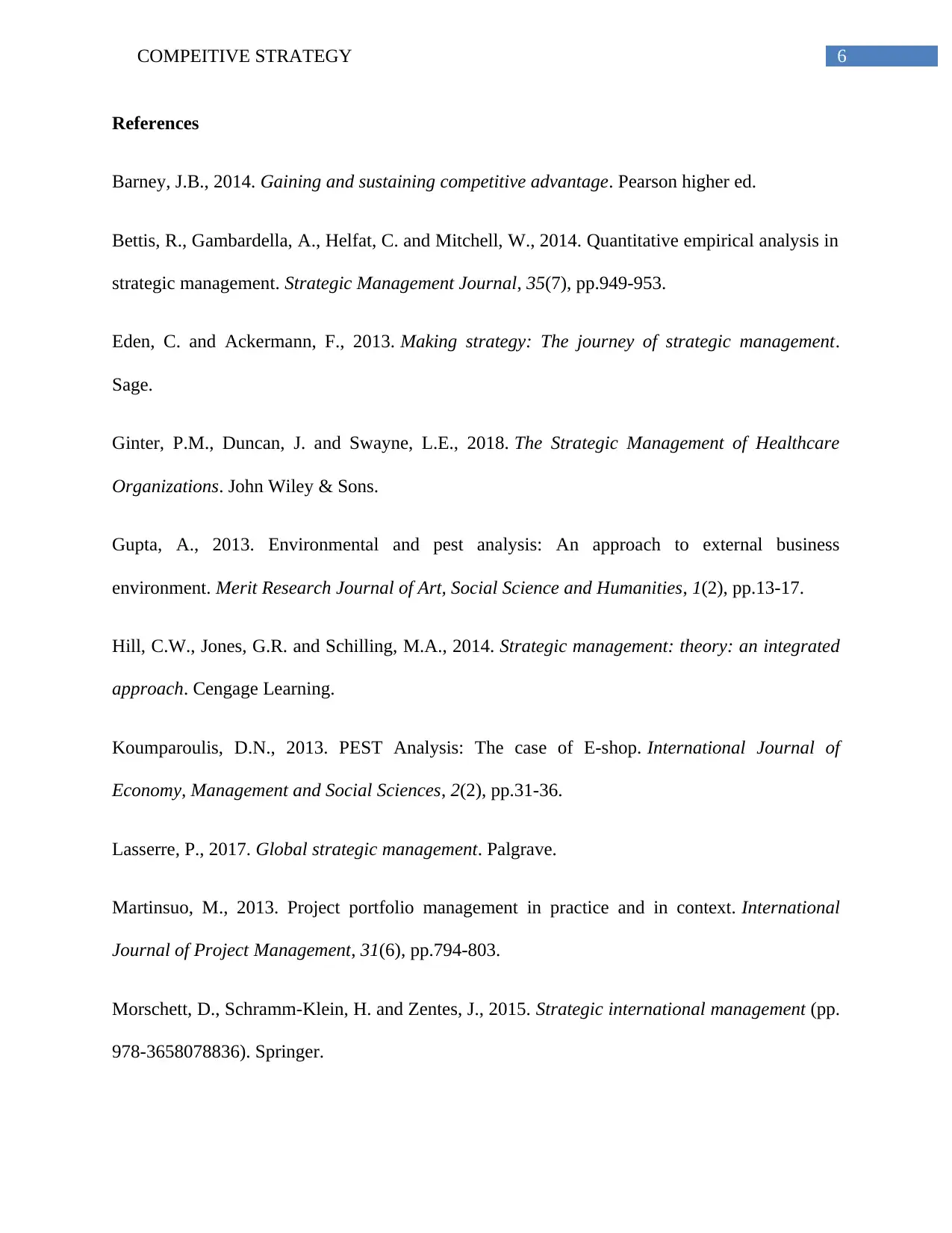
6COMPEITIVE STRATEGY
References
Barney, J.B., 2014. Gaining and sustaining competitive advantage. Pearson higher ed.
Bettis, R., Gambardella, A., Helfat, C. and Mitchell, W., 2014. Quantitative empirical analysis in
strategic management. Strategic Management Journal, 35(7), pp.949-953.
Eden, C. and Ackermann, F., 2013. Making strategy: The journey of strategic management.
Sage.
Ginter, P.M., Duncan, J. and Swayne, L.E., 2018. The Strategic Management of Healthcare
Organizations. John Wiley & Sons.
Gupta, A., 2013. Environmental and pest analysis: An approach to external business
environment. Merit Research Journal of Art, Social Science and Humanities, 1(2), pp.13-17.
Hill, C.W., Jones, G.R. and Schilling, M.A., 2014. Strategic management: theory: an integrated
approach. Cengage Learning.
Koumparoulis, D.N., 2013. PEST Analysis: The case of E-shop. International Journal of
Economy, Management and Social Sciences, 2(2), pp.31-36.
Lasserre, P., 2017. Global strategic management. Palgrave.
Martinsuo, M., 2013. Project portfolio management in practice and in context. International
Journal of Project Management, 31(6), pp.794-803.
Morschett, D., Schramm-Klein, H. and Zentes, J., 2015. Strategic international management (pp.
978-3658078836). Springer.
References
Barney, J.B., 2014. Gaining and sustaining competitive advantage. Pearson higher ed.
Bettis, R., Gambardella, A., Helfat, C. and Mitchell, W., 2014. Quantitative empirical analysis in
strategic management. Strategic Management Journal, 35(7), pp.949-953.
Eden, C. and Ackermann, F., 2013. Making strategy: The journey of strategic management.
Sage.
Ginter, P.M., Duncan, J. and Swayne, L.E., 2018. The Strategic Management of Healthcare
Organizations. John Wiley & Sons.
Gupta, A., 2013. Environmental and pest analysis: An approach to external business
environment. Merit Research Journal of Art, Social Science and Humanities, 1(2), pp.13-17.
Hill, C.W., Jones, G.R. and Schilling, M.A., 2014. Strategic management: theory: an integrated
approach. Cengage Learning.
Koumparoulis, D.N., 2013. PEST Analysis: The case of E-shop. International Journal of
Economy, Management and Social Sciences, 2(2), pp.31-36.
Lasserre, P., 2017. Global strategic management. Palgrave.
Martinsuo, M., 2013. Project portfolio management in practice and in context. International
Journal of Project Management, 31(6), pp.794-803.
Morschett, D., Schramm-Klein, H. and Zentes, J., 2015. Strategic international management (pp.
978-3658078836). Springer.
Paraphrase This Document
Need a fresh take? Get an instant paraphrase of this document with our AI Paraphraser
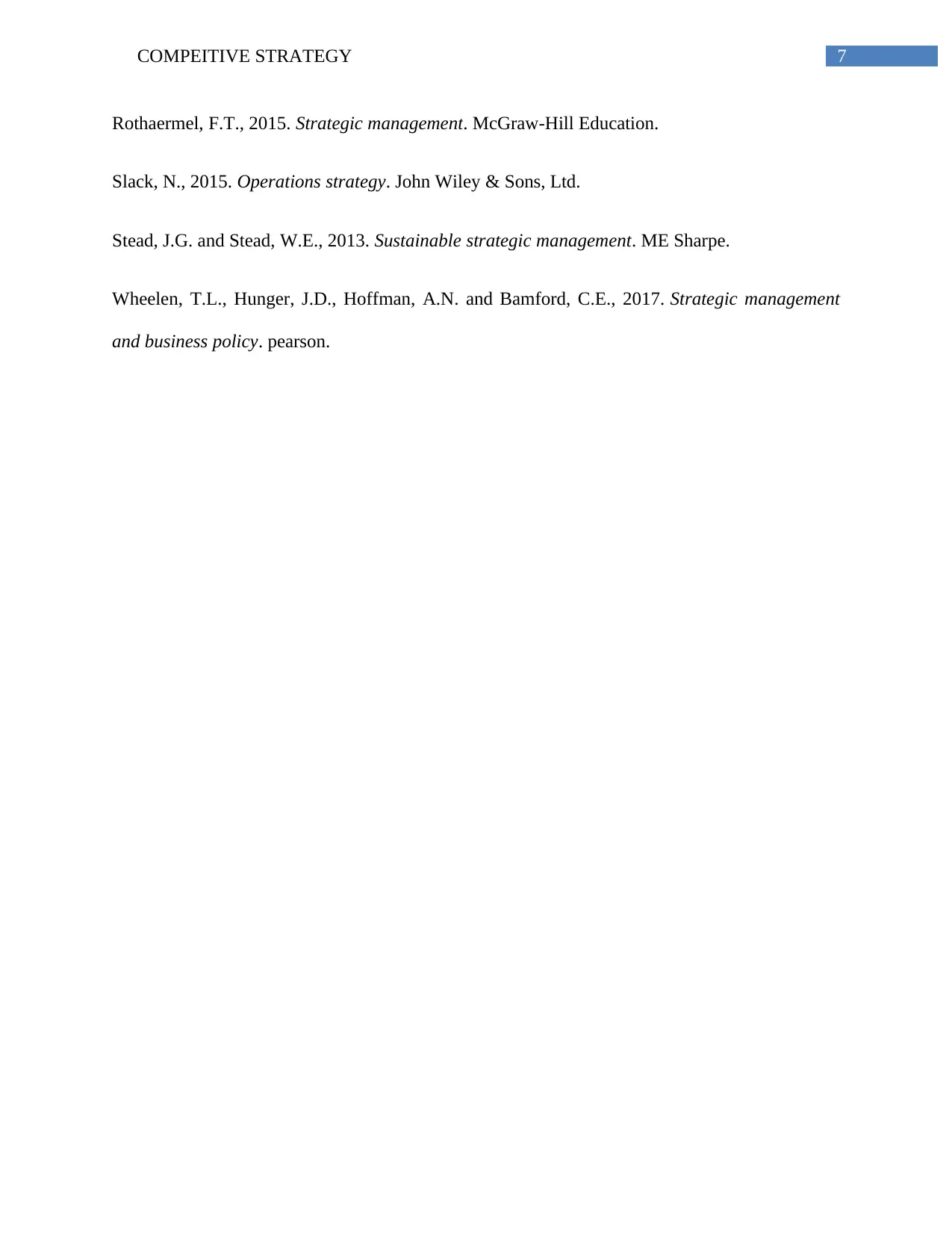
7COMPEITIVE STRATEGY
Rothaermel, F.T., 2015. Strategic management. McGraw-Hill Education.
Slack, N., 2015. Operations strategy. John Wiley & Sons, Ltd.
Stead, J.G. and Stead, W.E., 2013. Sustainable strategic management. ME Sharpe.
Wheelen, T.L., Hunger, J.D., Hoffman, A.N. and Bamford, C.E., 2017. Strategic management
and business policy. pearson.
Rothaermel, F.T., 2015. Strategic management. McGraw-Hill Education.
Slack, N., 2015. Operations strategy. John Wiley & Sons, Ltd.
Stead, J.G. and Stead, W.E., 2013. Sustainable strategic management. ME Sharpe.
Wheelen, T.L., Hunger, J.D., Hoffman, A.N. and Bamford, C.E., 2017. Strategic management
and business policy. pearson.
1 out of 8
Related Documents
Your All-in-One AI-Powered Toolkit for Academic Success.
+13062052269
info@desklib.com
Available 24*7 on WhatsApp / Email
![[object Object]](/_next/static/media/star-bottom.7253800d.svg)
Unlock your academic potential
Copyright © 2020–2025 A2Z Services. All Rights Reserved. Developed and managed by ZUCOL.




